
STATE OF GREEN Inflight Magazine Connect. Inspire. Share. Think Denmark stateofgreen.com Discover Denmark’s resource-efficient industries
Inflight Magazine 2024 CSI edition
Discover Denmark s resource-efficient industries
Editor
StateofGreen:MariaLindArlaud, mla@stateofgreen.com
StateofGreen:JoelMatiasJonsson, jjo@stateofgreen.com
Cases provided by
KalundborgSymbiosis
Greenlab
ArlaFoods
BillundBioRefinery
CrossbridgeEnergy
Design
Essensen
Front page photo
Kalundborg Symbiosis
Download this publication
Download this and other publications at stateofgreen com/publications
For more information
To order copies of this publication or receive more information about other related publications, please contact State of Green at info@stateofgreen com
Copyright notice
©State of Green (2023)
Forewords
Welcome to Denmark
In a time where global resources are becoming increasingly scarce and the industrial sectors account for over 20 percent of total greenhouse gas emissions, major industries need to adapt and limit their energy and water consumption.
This is why the European Union and its member states agreed to commit to an ambitious energy efficiency target of at least 32.5 percent by 2030 compared to projections of the expected energy use. Besides being a cornerstone in delivering on the Paris Agreement, resource conservation and energy efficiency reduce costs, lower air pollution, and improve competitiveness. Producing more with less is now more crucial than ever before.
Furthermore, Denmark is committed by law to reducing its greenhouse gas emissions by 70 percent by 2030 compared to 1990 levels. Promoting energy efficiency is an essential part of the plan, and the Danish journey toward a more energy-efficient society traces back to the early 1970s.
Since then, public and private players have worked together to secure Denmark’s position at the forefront of renewable energy, energy-efficient solutions, and sector integration within industries, such as the food and beverage industries.

This has taught us valuable lessons and experiences, showing that the pursuit of energy efficiency is a multifaceted endeavour; and that economic growth and energy consumption not necessarily need to go hand-in-hand.
Standing on the shoulder of more than five decades of dedicated efforts, I hope that Danish lessons as presented in this inflight magazine will inspire and instigate an even greater appetite for energy-efficient measures before your visit to Denmark.
By Finn Mortensen Executive Director, State of Green
DISCOVER DENMARK’S RESOURCE-EFFICIENT INDUSTRIES 3 STATE OF GREEN

PHOTO: KALUNDBORG SYMBIOSIS

Introduction
Denmark’s road to resource-efficient industries
Decarbonising energy-intensive industries
Denmark’s journey towards energy efficiency
Solutions
Case 1: Kalundborg Symbiosis
The world’s first industrial symbiosis: from waste stream to resource currents
Case 2: GreenLab
The green industrial park of the future
Case 3: Billund BioRefinery
Turning urban waste into green resource streams
Case 4: Arla Foods
Optimising energy streams with electric heat pumps
Case 5: Port of Esbjerg
The gateway to northern Europe's offshore wind energy
Case 6: Crossbridge Energy
Taking part in the green transition
White paper: Sustainable Industries 6 6 7 9 12 14 16 18 20 22 Content 5
Denmark’s road to resource-efficient industries
All
over
the world, industries
across sectors are facing a pressing dilemma: the escalating scarcity of resources. This calls for a decarbonisation of industries using heavy amounts of energy and water, instead shifting to a focus on sustainable resource consumption through resource-efficient solutions.
With global population and income levels going up, so is the use of resources worldwide. This especially accounts for energy, which is used to power our homes and produce various goods and services, as well as water, which is vital for survival, development, and production across sectors. These precious yet limited resources pose a challenge to industries striving to curtail their substantial daily consumption.
This calls for a paradigm shift towards producing more while using less – not only to reduce environmental impact but also to harness the competitive advantages in heightened production efficiency.
Decarbonising energy-intensive industries
The Food and Agriculture Organization of the United Nations, FAO, indicates that by 2050, a 70 percent increase in current food production will be necessary. 70%
Industrial sectors are responsible for over 20 percent of total greenhouse gas emissions, placing a high amount of pressure on energy and water resources. Energyintensive sectors, such as the food and beverage industry, require significant amounts of energy in the production, process, and transportation of products.
It is estimated that the food and beverage industry accounts for approximately 30 percent of global energy consumption in the industrial sector. Furthermore, the food and beverage processing industry has significant potential for cost reductions, particularly in the area of
energy efficiency, where the cost of milk and cheese processing can be reduced by over 30 percent.
As an important tool to address these challenges, the implementation of energy-efficient solutions is essential. By optimising energy usage and reducing waste, especially in energy-heavy industries, companies can achieve significant cost savings and secure sustainable resource consumption, while enhancing their market competitiveness and improving operational efficiency.
55-65%
In 2021, the Danish Parliament passed an agreement, which commits the Danish food & agriculture sector to reduce its greenhouse gas emissions by 55-65 percent by 2030 compared with 1990 levels.
STATE OF GREEN 6 INFLIGHT MAGAZINE
Denmark’s journey towards energy efficiency
Energy efficiency has been an embedded part of Denmark’s mindset for decades, as Denmark has worked with energy efficiency measures since the 70s. With different policies, initiatives, and instruments implemented, spanning from normative, informative, and economic purposes, it has been proved that decoupling economic growth from an increase in energy consumption is possible. Furthermore, there is great potential in harvesting low-hanging fruits from conducting energy efficiency improvements.
Danish food and beverage producers have been refining their methods to produce more with less for a number of years now. The Danish industry as a whole has reduced energy intensity in production by more than 50 percent from 1990 to 2018 and decreased by approximately 40 percent in the EU.
The Danish food sector, in particular, has undergone significant development over the years. From the end of the 1960’s, the production value of the Danish food industry has gone up by over 80 percent while the energy consumption from food production has reduced with over 20 percent. →
Danish industry boasts one of the lowest rates of energy intensity among European countries at approximately half the intensity of the EU28 average. This is partly due to concerted efforts by industry – incentivised through regulation, financing and increased awareness. These efforts have reduced energy intensity in industry by 50 percent since 1990, by 16 percent since 2010, and the quest for improving energy efficiency continues.
STATE OF GREEN DISCOVER DENMARK’S RESOURCE-EFFICIENT INDUSTRIES
7
Energy intensity in industry, TJ per million Euro (2019)
6,0 5,0 4,0 2,0 1,0 3,0 0 EU28 Germany Ireland Italy Netherlands Denmark France Sweden UK Austria Belgium Poland Norway Spain
Source: White paper "Sustainable Industries"
Additionally, the industry has managed to reduce its emissions by 16 percent between 1990 – 2016, while simultaneously increasing production rate by 31 percent.1
Therefore, industry stands out as a frontrunner in energy efficiency compared to other sectors of the economy. Experience shows that large efficiency improvements can be achieved through optimised production equipment, building and workflow by realising the full potential of digitalisation and behavioral changes. Moreover, a strong focus from management's side is needed.
Further improvements are obtained by switching to a greener energy supply, and by harvesting the potential in surplus energy and water resources that would otherwise have been wasted.
The solutions needed for a green transition of global industries are in many cases already available and the potential for saving energy is tremendous. Improved efficiency of energy, water, and other resource consumption will allow industry to realise substantial economic gains now, while contributing to the realisation of the Paris Agreement and the Sustainable Development Goals. Especially in regards to the goals focusing on clean energy, clean water, industry, sustainable cities, and climate action.
STATE OF GREEN 8 INFLIGHT MAGAZINE
https://agricultureandfood.dk/climate-neutral-2050/climate-neutral-2050 Energy efficiency in the Danish food industry Index, 1966=100 Index Year 186 77 Production value Source: Danish Agriculture and Food Council & Statistic Denmark Energy consumption 200 150 100 50 0 1966 1968 1970 1972 1974 1976 1978 1980 1982 1984 1986 1988 1990 1992 1994 1996 1998 2000 2002 2004 2006 2008 2010 2012 2014 2016 2018 2020 2022
White paper: Sustainable industries
Interested in learning more about how Denmark has worked on securing resource and energy efficiency throughout industrial sectors?
Presenting a deep dive into the Danish industrial landscape, State of Green’s white paper on “Sustainable Industries” offers insights and examples of innovative solutions contributing to the nation’s 24 percent decrease in energy consumption over the last two decades.
Discover the impact of resource efficiency in industries and learn how innovative Danish companies are reshaping production models, optimizing supply chains, and reducing waste. Explore the regulatory framework driving energy efficiency and understand how policies are propelling industries towards greener operations, fostering economic growth and environmental preservation in the process.
We hope that the white paper can act as a source of inspiration, fostering more sustainable industries and resource efficiency benefiting both businesses and society in the future.

White paper: Sustainable Industries
This whitepaper provides insight into the sustainable journeys of multiple industrial sectors in Denmark. Get to know the solutions of the food and beverage sector, the lifescience and pharmaceutical sector, and the manufacturing sector, while learning about the innovative concept of industrial symbiosis.

Discover the white paper at https://stateofgreen.com
9 DISCOVER DENMARK’S RESOURCE-EFFICIENT INDUSTRIES
DISCOVER
STATE OF GREEN
Cases Danish solutions

10 STATE OF GREEN INFLIGHT MAGAZINE P H O T O : F O O D N A T I O N / N I E L S H O U G A A R D
CASE 1 • KALUNDBORG SYMBIOSIS
THE WORLD’S FIRST INDUSTRIAL SYMBIOSIS: FROM WASTE STREAM TO RESOURCE CURRENT
CASE 2 • GREENLAB
THE GREEN INDUSTRIAL PARK OF THE FUTURE
CASE 3 • BILLUND BIOREFINERY
TURNING URBAN WASTE INTO GREEN RESOURCE STREAMS
CASE 4 • ARLA FOODS
OPTIMISING ENERGY STREAMS WITH ELECTRIC HEAT PUMPS
CASE 5 • PORT OF ESBJERG THE GATEWAY TO NORTHERN EUROPE’S OFFSHORE WIND ENERGY
CASE 6 • CROSSBRIDGE ENERGY TAKING PART IN THE GREEN TRANSITION
STATE OF GREEN
DISCOVER DENMARK’S RESOURCE-EFFICIENT INDUSTRIES
11
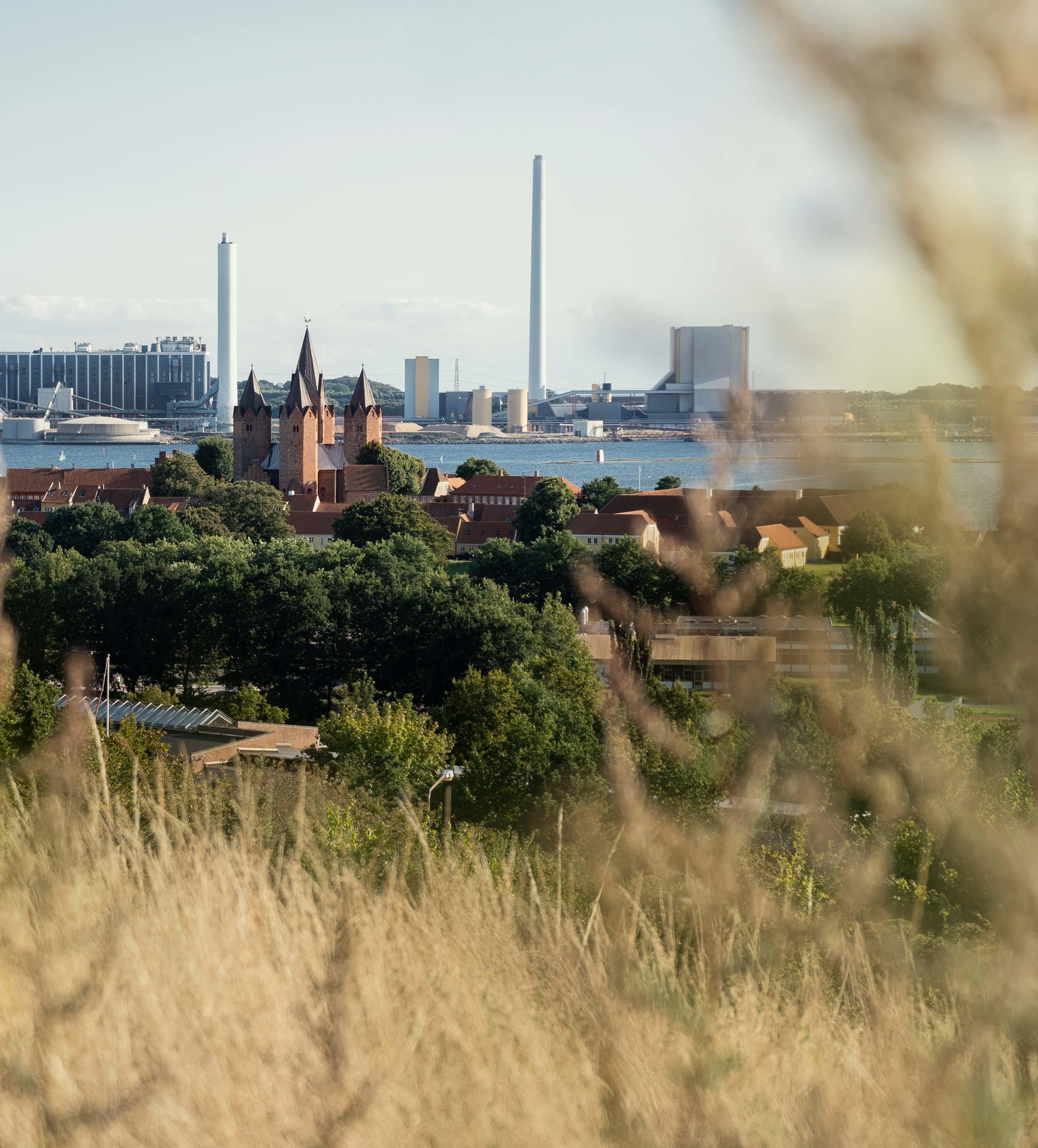
CASE 1 KALUNDBORG SYMBIOSIS
TAG INDUSTRIAL SYMBIOSIS
LOCATION KALUNDBORG, DENMARK
The world’s first industrial symbiosis: from waste stream to resource current
Challenge
It takes about 1.5 years to replace what we use and consume in one year. This requires a new way of thinking and a new economic model – one which encourages the use of circular business models and reuse of resources.
This is exactly what the symbiosis model strives to do. With a main aim to reuse resources in a mutually beneficial way, reducing consumption and saving money, an industrial symbiosis is a partnership between different industries and business to share resources, such as materials, energy, water, and expertise.
STATE
OF GREEN
12 INFLIGHT MAGAZINE
PHOTO: KALUNDBORG SYMBIOSIS
Every year, the symbiosis saves partners and the environment:
• 62.000 tonnes of residual materials which are recycled.
• 4 million m3 of groundwater by using surface water instead.
• 586.000 tonnes of CO2 emissions.
• 80 percent of the CO2 emissions in the Symbiosis have been reduced since 2015.
• The local energy supply is now CO2-neutral.
Solution
Developed back in 1972, Kalundborg Symbiosis was the first industrial symbiosis in the world. With its circular approach to production, Kalundborg Symbiosis remains as one of the world’s leading industrial symbioses and is today a partnership between sixteen public and private companies in the municipality of Kalundborg in Denmark. The project facilitates an opportunity for the companies to synergistically leverage each other's residual and byproducts, sharing and reusing resources, thus making savings and minimizing waste. The collaborative approach
bolsters production without imposing additional strains on energy, water, or natural resources.
For example, biotech companies such as Novozymes and Novo Nordisk contribute with their residual biomass to Kalundborg Bioenergy, a biogas plant owned and operated by Bigadan. Here, biogas is produced and upgraded to natural gas quality through a refining process where carbon dioxide and hydrogen sulphide are removed from the product. Biomethane is send to local companies, Gyproc, Unibio and Kalundborg Refinery, and to end consumers via the national gas grid. Sulphur from the hydrogen sulphide fraction is collected and reused in fertilizer products together with the gasified biomass residual. In conclusion, the symbiosis turns one company’s waste into a steady resource flow for another, benefiting both the environment and the economy.
Result
Kalundborg Symbiosis is a perfect demonstration of circular economy: residue is used for energy production in a local set-up, saving transportation costs on both biomass (supply) and fertiliser (output) over long distances. The cooperation ensures local companies obtain a green energy supply at the same time as resources are being used, shared, and saved in a sustainable way.
The Kalundborg Symbiosis is a great example of a circular business model, creating growth in the local community, while supporting the green transition.


About
Kalundborg Symbiosis is a partnership between sixteen public and private companies in Kalundborg. The main principle is that a waste stream in one company becomes a resource in another, benefiting both the environment and the economy.
Discover Kalundborg Symbiosis at stateofgreen.com
13 STATE OF GREEN
DISCOVER DENMARK’S RESOURCE-EFFICIENT INDUSTRIES
FACTS
PHOTO: KALUNDBORG SYMBIOSIS
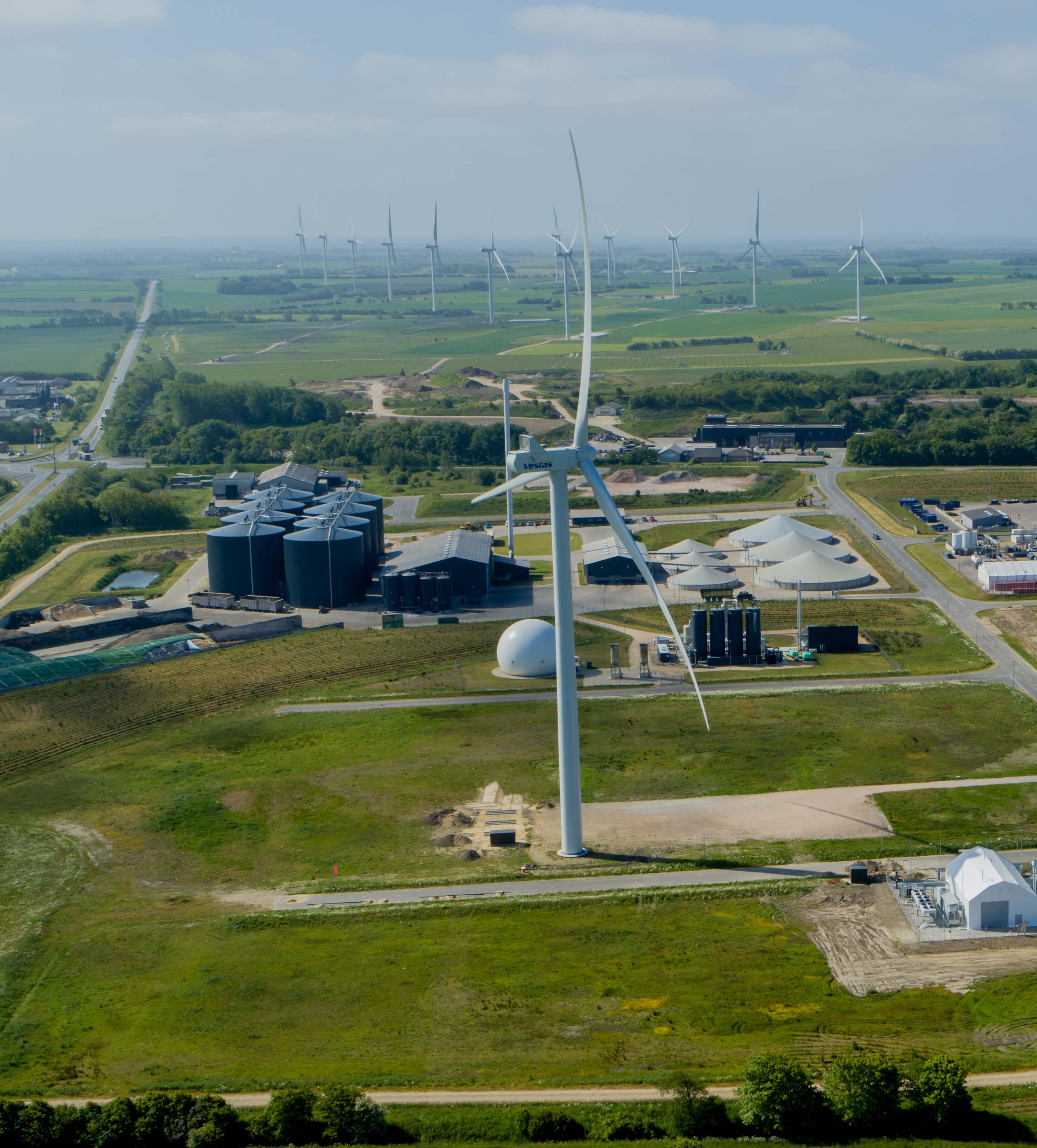
CASE 2 GREENLAB
TAG INDUSTRIAL SYMBIOSIS
LOCATION SKIVE, DENMARK
GreenLab: the green industrial park of the future
Challenge
The green transition requires investment in emerging technologies, the facilitation of new collaborations, and the willingness to lean into uncertainty and complexity with no guarantee of a big return. However, it is essential for driving change in the green transition of industries and hard-to-abate sectors.
So, how can you succeed in transforming a green field into a unique, green, and circular industrial park that facilitates complex projects, accelerates emerging technologies, and simultaneously focuses on minimising industrial waste in just four years?
STATE
OF GREEN
PHOTO: GREENLAB 14 INFLIGHT MAGAZINE
Solution
GreenLab – a unique, green and circular industrial park was established in 2019 and is a public-private partnership between Skive Municipality, Norlys, Spar Vest Fonden and Klimafonden. In 2021, the Danish government designated GreenLab as an official regulatory test zone granting GreenLab the opportunity to try new circular business models and direct connections between renewable energy and industry, including the companies at GreenLab and its power-to-X test site.
GreenLab will be the first site in Denmark to connect renewable energy to industry and power-to-X through a direct connection, and is internationally acknowledged as a frontrunner and a bestpractice example of an industrial symbiosis.
The test zone permit is one of a kind in Europe, providing valuable insights for all of Europe’s green transition –including clean energy storage, green fuels, agriculture, and industry.
GreenLab acts as a facilitator for complex and risky projects, taking responsibility for collaboration
agreements with several stakeholders, contact with state-owned companies, as well as steering committee meetings and support off-take arrangements.
GreenLab brings together energy producers and industrial energy consumers, and the co-location and integration of production and consumption increases the likelihood of reaching parity and reduces the need for transportation of energy, which is often very expensive.
Result
GreenLab will be the first site in Denmark to connect renewable energy to industry and power-to-X through a direct connection, and is internationally acknowledged as a frontrunner and a best-practice example of an industrial symbiosis. The six active companies located in the industrial park focus on zero waste in their work with technologies like pyrolysis, electrolysis etc., to create marine protein, biochar, biogas, naphtha, green hydrogen, and other green products. GreenLab and its site partners have created local green growth, generated more than 100 jobs and attracted over 3 billion in investments, including an 80 MW renewable energy site located near the green industrial park.
In August 2023, the United Nations Industrial Development Organisation published a report on guidelines for developing green industrial hydrogen clusters. GreenLab is a contributor and is highlighted by the UN as a best-practice example.

About
GreenLab is a unique, green and circular industrial park that generates sustainable energy, supplies it to local businesses, and transforms it into heat, electrofuels, and other green products.
Discover GreenLab at stateofgreen.com
15 STATE OF GREEN
DISCOVER DENMARK’S RESOURCE-EFFICIENT INDUSTRIES
PHOTO: GREENLAB
IN INDUSTRIES
GRINDSTED, DENMARK

Turning urban waste into green resource streams
Challenge
Most urban waste management strategies are aimed at reducing the eventual load on the environment after disposal. But to achieve the energy efficiency and circularity so desperately needed in the green transition, waste should be seen as a resource to not just manage but utilise. For instance, if we let organic household waste go to waste, we miss out on potential biogas that can be used for electricity or heating and the recyclable nutrients, phosphorous in particular. If urban waste streams are to be optimally utilised, it requires treatment solutions that are safe, smart and holistic.
16
CASE
TAG LOCATION
EFFICIENCY
STATE OF GREEN
3
BILLUND BIOREFINERY
INFLIGHT MAGAZINE
P H O T O : B I L L U N D B I O R E F I N E R Y
Solution
Billund BioRefinery (BBR) is a pathbreaking example of how urban waste streams can be turned into profitable resources while being uncompromising with regards to environmental protection and sustainability The facility is a modern-day refinery that uses waste streams instead of traditional crude oil to generate electrical and heat energy and to produce cleaned water and high-quality natural manure.
The BBR receives urban wastewater and source separated organic household wastes along with organic industrial wastes. These streams are processed through a generic wastewater treatment plant, and a highly effective three step anaerobic Digestion- thermal Lysis – anaerobic Digestion (DLD) system. The lysis process comprises of the innovative ExelysTM thermal hydrolysis reactor. The nitrogen rich reject water from the anaerobic processes is cleaned using AnitaMoxTM, an anammox process. The BBR uses online monitoring and control thus reducing the number of human hours required for the operation of the plant.
Results
The BBR is able to generate up to three times the energy it uses in its entire concern which includes the energy for water supply, sewerage collection and the treatment processes themselves. This excess energy is sold to the local electricity grid and to the district heating grid. The nutrient rich natural manure which is strictly regulated by the government and subjected to rigorous quality checks is supplied to the local farming community thus improving phosphorous security
Importantly, the core product of a wastewater treatment plant – clean water – is also significantly improved. The outlet quality of the treated wastewater is much higher than what is required by regulations: the effluent nutrient concentration is only a quarter of the level required by the Danish legislation.
Ultimately, the BBR is a scalable and relatively easily implementable model for circular economy. It is also a fine example of a successful Public-Private partnership.


Wasteandwastewaterarenotproblems–they areresourcesthatofferimmensepotentialforthe environment.Thisisthephilosophybehindthe BillundBioRefinerythatcombinesthestrongest environmentaltechnologieswithinwater treatmentandbiogasinonesignificant,full-scale demonstrationproject
Discover Billund BioRefinery at stateofgreen.com
DISCOVER DENMARK’S RESOURCE-EFFICIENT INDUSTRIES 17
STATE OF GREEN
About P H O T O : B I L L I N D B I O R E F I N E R Y
STATE OF GREEN
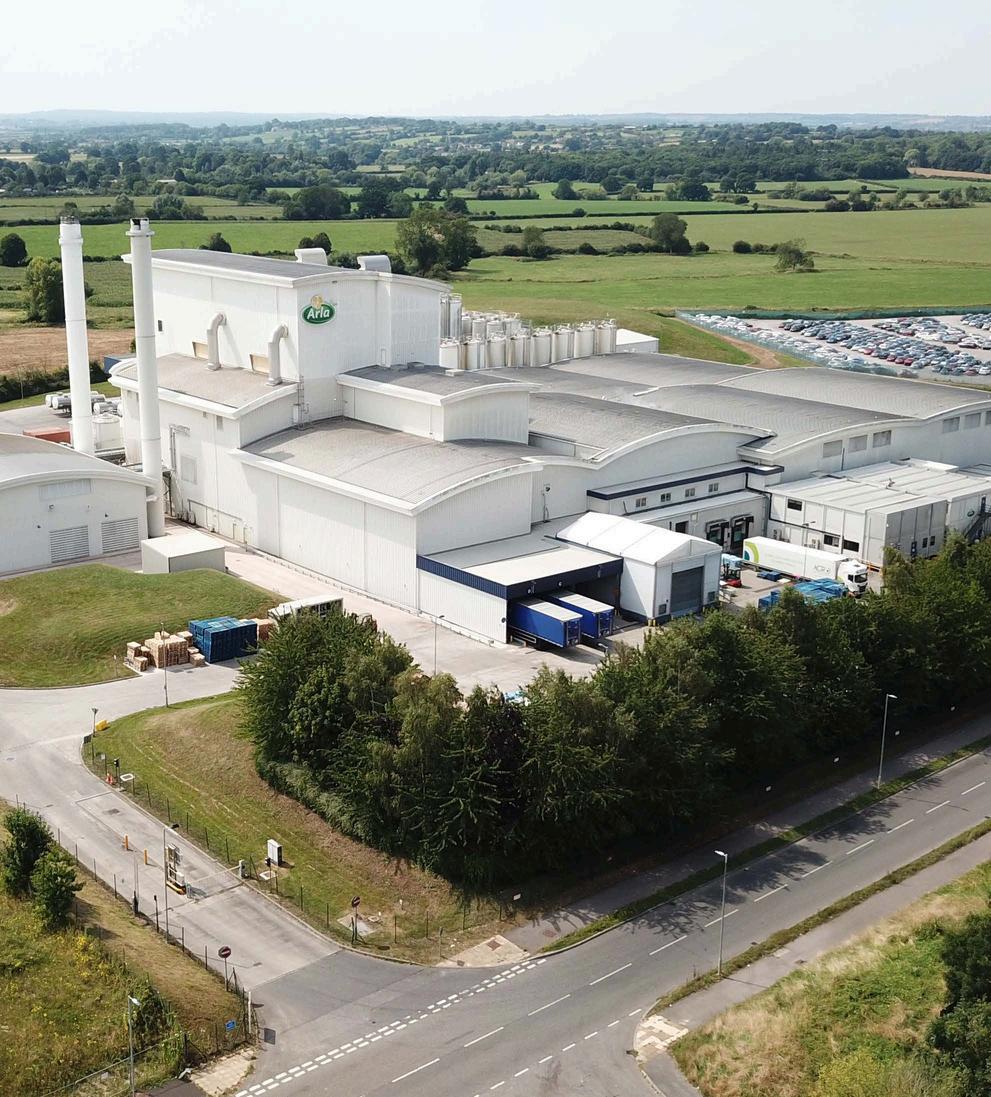
CASE 4
TAG
LOCATION
OPTIMISING ENERGY STREAMS
RESOURCE EFFICIENT PRODUCTION OF FOOD
VIDEBÆK, DENMARK
Optimising energy streams with electric heat pumps
Challenge
Arla Foods, one of the biggest dairy companies in the world, has set an ambitious target of becoming carbon neutral by 2050, and a goal of deriving 100 percent of the used electricity from renewable sources by 2025. With a focus on efficiency targets based on quantifiable data, Arla has set a target of reaching a 63 percent reduction in carbon emissions across its 60 global facilities.
One of these facilities is the Danmark Protein site, located in Videbæk
18
INFLIGHT MAGAZINE
P H O T O : G R U N D F O S
→
Covering 80,000 m2, it is the world’s largest whey protein and lactose factory, producing more than 80 different whey ingredients around the clock every day The high temperatures needed to produce these products make for an energy intensive operation. As Arla Foods faces increasing demand for their whey products, it is imperative to find sustainable and energy efficient ways to support the company’s growth
Solution
In a step towards its carbon reduction goals, Arla Foods has invested EUR 32 million in an energy-saving electric heat pump facility at the Danmark protein site.
This shift to heat production by electricity, rather than gas, is expected to cut the site’s greenhouse gas emissions by an estimated 14,500 tonnes CO₂ equivalent a year – a 22 percent reduction compared to 2023, and a significant contribution to the CO₂ reduction target.
Once fully operational, the facility will have the capacity to convert 2.8MW of electricity into 8MW of heat and 5 7MW of ice water for cooling purposes By 2026, it will run entirely on green electricity, supporting the transition away from fossil-based natural gas.
The heat will be fed into Danmark Protein’s 90°C heat distribution system, providing hot water for processes such as clean-in-place, heat treatment and the preheating of air in the spray-drying towers. This will replace heat previously supplied by gas-fired boilers.
Result
The heat pump technology will effectively allow the Danmark Protein site to split its energy system, so that it can supply more sustainably generated heat to lower temperature users while channeling efforts into developing better solutions for its few hightemperature needs
Construction of the heat pump facility began at the site in January 2024, with operation scheduled to begin in 2025. Provision for a future expansion to 12MW of heat-producing capacity is already built into the design to accommodate production growth in the years ahead


ArlaFoodsisadairycooperativeownedby8,000farmers fromsevenEuropeancountries Annually Arlacollectsaround 14billionkgofmilkfromitsfarmerownersmakingArlathe world’s6thlargestdairycompany Arlasglobalbrandsinclude Arla®,Lurpak®andPuck® ItisthevisionofArlatocreatethe futureofdairy,tobringhealthyandsustainabledairyproducts topeopleacrosstheworldandtoleadthetransitiontowards sustainabledairyfarmingandproduction
Arla has set a target of reaching a 63 percent reduction in carbon emissions across its 60 global facilities.
As the largest investment of its kind by Arla Foods, the project will provide a blueprint for replication at other sites.
Discover Arla Foods at stateofgreen.com
STATE OF GREEN DISCOVER DENMARK’S RESOURCE-EFFICIENT INDUSTRIES 19
About
P H O T O : A R L A F O O D S C R E D I T : F O O D N A T I O N & N I E L S H O U G A A R D
63%
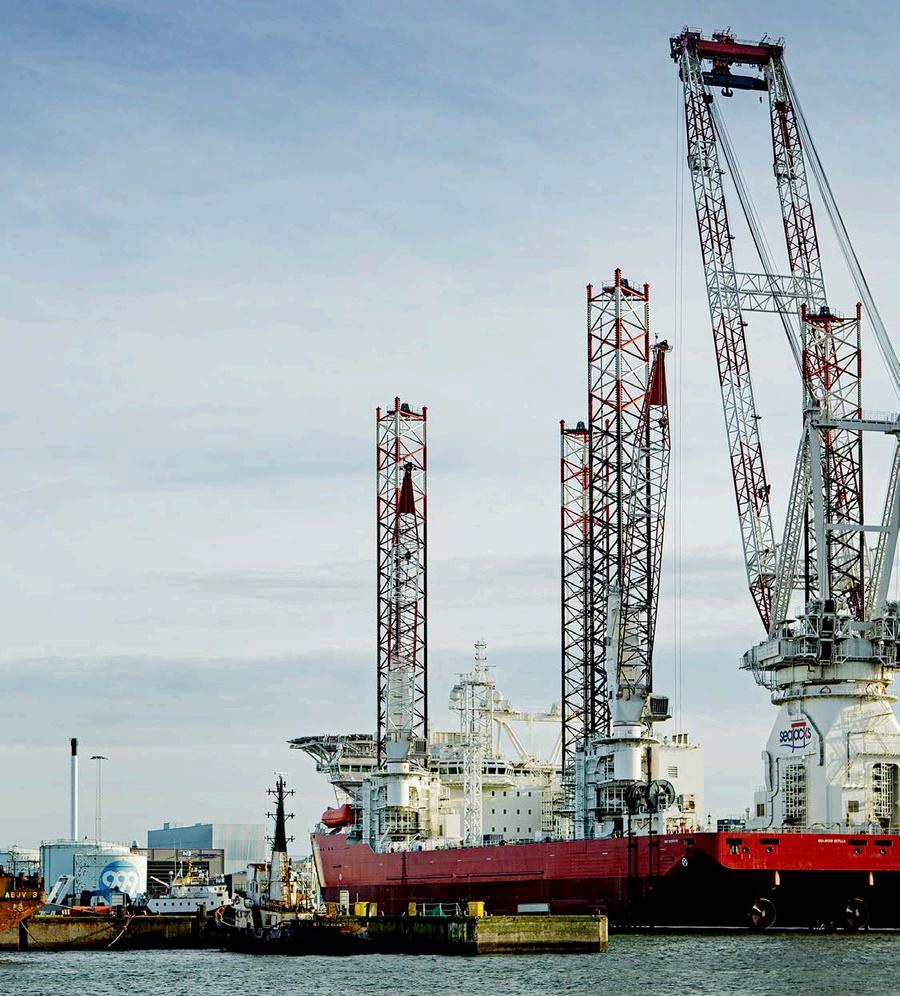
The gateway to Northern Europe’s offshore wind energy
Challenge
Reducing greenhouse gas emissions and mitigating the impacts of climate change are becoming increasingly pressing issues. Offshore wind energy plays a key role in this by providing a clean, renewable energy source, which has been a major part of Denmark’s and Europe’s energy supply. →
DISCOVER DENMARK’S RESOURCE-EFFICIENT INDUSTRIES INFLIGHT MAGAZINE STATE OF GREEN CASE 3 TAG LOCATION PORT ESBJERG WIND TURBINE MANUFACTURING AND
COMPONENTS ESBJERG, DENMARK
20
However, the rising demand for wind energy installation along with the increasing size of components has brought new challenges to overcome, with manufacturing, assembling and transport of blades, turbines and other parts adding pressure on infrastructure
Hence, ports that can offer capacity, access and support, plays an integral role for the growing offshore wind industry.
Solution
The Port of Esbjerg, originally built in 1868 as a fishing harbour, is Denmark’s largest port and a crucial part of a specialised network of ports in the offshore wind sector. Covering 4 5 million square meters, Port of Esbjerg is now the world’s largest base port for offshore wind activities and a front runner in the European offshore wind sector. The port is home to more than 200 companies employing around 10.000 workers.
One of the port’s key competitive advantages is that it is a key link between production facilities in Northern Europe and offshore wind sites in the North Sea and surrounding waters. The Port of Esbjerg is the only place in the world, home to companies from the entire wind value chain From R&D, manufacturing, over transport, and preassembly, to installation and maintenance.
Result
The transformation from a fishing harbour to an energy metropolis has generated extensive job growth and attracted investments, habitants and workers to the city of Esbjerg. With its prime location by the North Sea, The Port of Esbjerg has become a key player in the European offshore wind sector, shipping out to more than 80 percent of the installed offshore wind capacity in Europe.
The local prosperity has also had positive spill-over effects on the national level, contributing to the broader success story of the Danish wind industry.

80%
WithitsprimelocationbytheNorthSea,ThePortofEsbjerg hasbecomeakeyplayerintheEuropeanoffshorewind sector,shippingouttomorethan80percentoftheinstalled offshorewindcapacityinEurope.
However, the transformation is far from over, and the port needs to focus on scalability, flexibility and industry collaboration to meet the challenges posed by the everevolving wind industry.

About
PortEsbjergistheNorthSea’sleadingportfor offshorewind,basetotheDanishoffshoreindustry andaninternationalhubformultimodaltransportwith sixregularRoRolinerservices.Beingthelargestport inDenmark,morethan6000vesselscallsthePortof Esbjergeveryyear,4.5milliontonnesofcargois handledattheport,1,000-1,500MWofoffshorewind capacityisshippedout,and70,000carsimported.
Discover Port of Esbjerg at stateofgreen.com
STATE OF GREEN DISCOVER DENMARK’S RESOURCE-EFFICIENT INDUSTRIES 21
CROSSBRIDGE ENERGY
EFFICIENCY IN INDUSTRIES
LOCATION
FREDERICIA, DENMARK

Taking part in the green transition
Challenge
Transport by land, at sea or up in the sky will also be a part of the green future. People will still have to go to work, school, attend meetings or buy groceries, and transportation will continuously be a significant part of our daily life. But how we transport goods and people is changing and is heading towards a greener future.
22
STATE OF GREEN
CASE 6 TAG
INFLIGHT MAGAZINE
P H O T O : C R O S S B R I D G E E N E R G Y →
So how do we produce the green liquid fuels that can ensure the part of transport that cannot be electrified such as ships, airplanes, heavy land transportation etc. will continue to function?
Crossbridge Energy’s ambition is to be a part of the needed green transition They are aiming to find the solutions to make a difference - to create a future, where goods can be delivered , planes can fly, ships can sail across the oceans and we can transport ourselves for in our daily lives in, all on green fuel.
Solution
Liquid fuels are an effective way to produce energy especially for heavy transportation. But where liquid fuels today are produced by fossil crude oil, the production will change as part of the green transition and will be produced by greener feedstocks This includes green hydrogen, and green carbon. Green hydrogen and green carbon are the building blocks for liquid fuel of the future and is developed right now. Crossbridge Energy are dedicated to find the greener solutions for large-scale production.
Results
Crossbridge Energy produces more than 35 percent of the Danish consumption of liquid fuels and is the only supplier of jet fuel in Denmark. In addition, Crossbridge Energy exports a correspondingly large share to the international market. The refinery in Fredericia is the largest supplier of surplus heat for district heating in Denmark and among the world's absolute most energyefficient refineries.
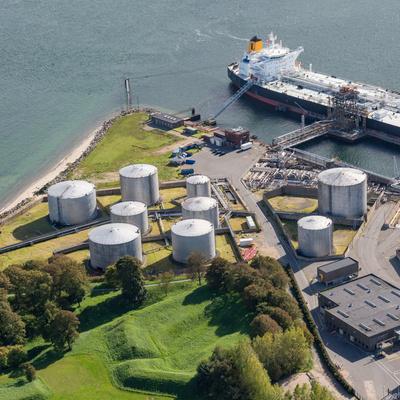

CrossbridgeEnergyproducesover35percentofall liquidfuelsusedinDenmarkandhasacorresponding exportviatheirportterminalinFredericia.Crossbridge Energyconsidersenergyefficiencytobeanabsolute toppriority,andtherefineryinFredericiaisoneofthe world'smostenergy-efficientrefineries.Thecompany employsabout270people. Discover Crossbridge Energy at stateofgreen.com
STATE OF GREEN DISCOVER DENMARK’S RESOURCE-EFFICIENT INDUSTRIES 23 P H O T O : C R O S S B R I D G E E N E R G Y
About
About State of Green
State of Green is a not-for-profit, public-private partnership between the Danish government and the country's three leading business associations (Confederation of Danish Industry, Green Power Denmark, and the Danish Agriculture and Food Council). State of Green is your one-stop-shop to more than 600 Danish businesses, agencies, academic institutions, experts and researchers. State of Green connects you with leading Danish players working to drive the global transition to a sustainable, low-carbon, resource-efficient society.
Learn more about sustainable industries, find more cases on efficient use of energy, water and resources, and connect with Danish expertise at:
Stateofgreen.com

























